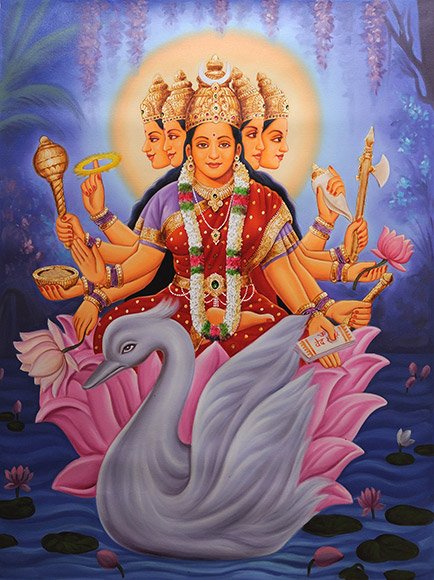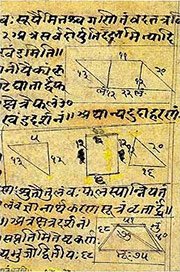Utkriti, Utkṛti: 11 definitions
Introduction:
Utkriti means something in Hinduism, Sanskrit, the history of ancient India. If you want to know the exact meaning, history, etymology or English translation of this term then check out the descriptions on this page. Add your comment or reference to a book if you want to contribute to this summary article.
The Sanskrit term Utkṛti can be transliterated into English as Utkrti or Utkriti, using the IAST transliteration scheme (?).
In Hinduism
Natyashastra (theatrics and dramaturgy)
Source: Wisdom Library: Nāṭya-śāstraUtkṛti (उत्कृति) refers to a class of rhythm-type (chandas) containing twenty-six syllables in a pāda (‘foot’ or ‘quarter-verse’), according to the Nāṭyaśāstra chapter 15. There are twenty-six classes of chandas and out of them arise the various syllabic meters (vṛtta), composed of four pādas, defining the pattern of alternating light and heavy syllables.

Natyashastra (नाट्यशास्त्र, nāṭyaśāstra) refers to both the ancient Indian tradition (shastra) of performing arts, (natya—theatrics, drama, dance, music), as well as the name of a Sanskrit work dealing with these subjects. It also teaches the rules for composing Dramatic plays (nataka), construction and performance of Theater, and Poetic works (kavya).
Chandas (prosody, study of Sanskrit metres)
Source: Shodhganga: a concise history of Sanskrit Chanda literatureUtkṛti (उत्कृति) is one of the twenty-six varieties of Sanskrit metres (chandas) mentioned in the Chandaśśāstra 1.15-19. There are 26 Vedic metres starting with 1 to 26 letters in each pāda. It is a common belief that the classical metres are developed from these 26 metres. Generally a metre has a specific name according to it’s number of syllables (akṣara). But sometimes the same stanza is called by the name of another metre from the point of view of the pādas.

Chandas (छन्दस्) refers to Sanskrit prosody and represents one of the six Vedangas (auxiliary disciplines belonging to the study of the Vedas). The science of prosody (chandas-shastra) focusses on the study of the poetic meters such as the commonly known twenty-six metres mentioned by Pingalas.
Ganitashastra (Mathematics and Algebra)
Source: archive.org: Hindu MathematicsUtkṛti (उत्कृति) represents the number 21 (twenty-one) in the “word-numeral system” (bhūtasaṃkhyā), which was used in Sanskrit texts dealing with astronomy, mathematics, metrics, as well as in the dates of inscriptions and manuscripts in ancient Indian literature.—A system of expressing numbers by means of words arranged as in the place-value notation was developed and perfected in India in the early centuries of the Christian era. In this system the numerals [e.g., 21—utkṛti] are expressed by names of things, beings or concepts, which, naturally or in accordance with the teaching of the Śāstras, connote numbers.

Ganitashastra (शिल्पशास्त्र, gaṇitaśāstra) refers to the ancient Indian science of mathematics, algebra, number theory, arithmetic, etc. Closely allied with astronomy, both were commonly taught and studied in universities, even since the 1st millennium BCE. Ganita-shastra also includes ritualistic math-books such as the Shulba-sutras.
India history and geography
Source: Cologne Digital Sanskrit Dictionaries: Indian Epigraphical GlossaryUtkṛti.—(IE 7-1-2), ‘twentysix’; rarely ‘twentyone’. Note: utkṛti is defined in the “Indian epigraphical glossary” as it can be found on ancient inscriptions commonly written in Sanskrit, Prakrit or Dravidian languages.

The history of India traces the identification of countries, villages, towns and other regions of India, as well as mythology, zoology, royal dynasties, rulers, tribes, local festivities and traditions and regional languages. Ancient India enjoyed religious freedom and encourages the path of Dharma, a concept common to Buddhism, Hinduism, and Jainism.
Languages of India and abroad
Sanskrit dictionary
Source: DDSA: The practical Sanskrit-English dictionaryUtkṛti (उत्कृति).—f. Name of a class of metres having 14 syllables.
Derivable forms: utkṛtiḥ (उत्कृतिः).
Source: Cologne Digital Sanskrit Dictionaries: Shabda-Sagara Sanskrit-English DictionaryUtkṛti (उत्कृति).—f.
(-tiḥ) 1. Cutting up. 2. A form of metre, a stanza of four lines of twenty-six syllables each. E. ut and kṛti another metre.
Source: Cologne Digital Sanskrit Dictionaries: Monier-Williams Sanskrit-English Dictionary1) Utkṛti (उत्कृति):—[=ut-kṛti] [from ut-kṛ] f. a metre of four times twenty-six syllables
2) [v.s. ...] the number twenty-six.
Source: Cologne Digital Sanskrit Dictionaries: Yates Sanskrit-English DictionaryUtkṛti (उत्कृति):—(tiḥ) 2. f. Cutting up.
[Sanskrit to German]
Sanskrit, also spelled संस्कृतम् (saṃskṛtam), is an ancient language of India commonly seen as the grandmother of the Indo-European language family (even English!). Closely allied with Prakrit and Pali, Sanskrit is more exhaustive in both grammar and terms and has the most extensive collection of literature in the world, greatly surpassing its sister-languages Greek and Latin.
Kannada-English dictionary
Source: Alar: Kannada-English corpusUtkṛti (ಉತ್ಕೃತಿ):—[noun] a metre having four lines of twenty six syllables each.
Kannada is a Dravidian language (as opposed to the Indo-European language family) mainly spoken in the southwestern region of India.
See also (Relevant definitions)
Ends with: Dushkriti, Muktaphutkriti, Phutkriti, Putkriti, Yajutkriti.
Full-text: Bhujangavijrimbhita, Bhujamgavijrimbhita, Urkiruti, Aticchandas, Apavaha, Kriti, Chandas, Chandomanjari.
Relevant text
Search found 6 books and stories containing Utkriti, Utkṛti, Utkrti, Ut-kriti, Ut-kṛti, Ut-krti; (plurals include: Utkritis, Utkṛtis, Utkrtis, kritis, kṛtis, krtis). You can also click to the full overview containing English textual excerpts. Below are direct links for the most relevant articles:
Vasudevavijaya of Vasudeva (Study) (by Sajitha. A)
Vṛttaratnāvalī of Ilattūr Rāmasvāmiśāstri < [Chapter 1 - Śāstrakāvyas—A Brief Survey]
Rig Veda (translation and commentary) (by H. H. Wilson)
Rig Veda 1.127.1 < [Sukta 127]
Amarakoshodghatana of Kshirasvamin (study) (by A. Yamuna Devi)
Education (8): Knowledge of Metres and Figures of speech < [Chapter 4 - Cultural Aspects]
Natyashastra (English) (by Bharata-muni)
Chapter XV - Verbal representation (vācika) and Prosody (chandaḥśāstra)
The Agni Purana (by N. Gangadharan)
Chapter 331 - Metres of different kinds
Chapter 337 - Description of the characteristics of a kāvya (kāvylakṣaṇa)
Dramaturgy in the Venisamhara (by Debi Prasad Namasudra)
Vṛttas (syllabic metres) < [Chapter 4 - Dramaturgy in Veṇīsaṃhāra]